
Pyramids of Güímar
Encyclopedia
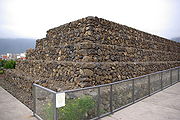
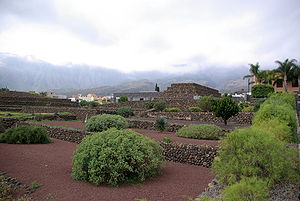
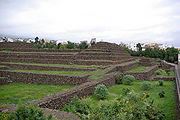
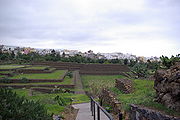
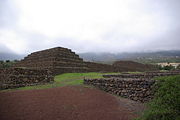
The Pyramids of Güímar refer to six rectangular pyramid
Pyramid
A pyramid is a structure whose outer surfaces are triangular and converge at a single point. The base of a pyramid can be trilateral, quadrilateral, or any polygon shape, meaning that a pyramid has at least three triangular surfaces...
-shaped, terraced structures, built from lava stone without the use of mortar
Mortar (masonry)
Mortar is a workable paste used to bind construction blocks together and fill the gaps between them. The blocks may be stone, brick, cinder blocks, etc. Mortar becomes hard when it sets, resulting in a rigid aggregate structure. Modern mortars are typically made from a mixture of sand, a binder...
. They are located in the district of Chacona, part of the town of Güímar
Güímar
Güímar is the name of a municipality, town, and valley in the eastern part of the Spanish island of Tenerife, one of the Canary Islands, and part of Santa Cruz de Tenerife...
on the island of Tenerife
Tenerife
Tenerife is the largest and most populous island of the seven Canary Islands, it is also the most populated island of Spain, with a land area of 2,034.38 km² and 906,854 inhabitants, 43% of the total population of the Canary Islands. About five million tourists visit Tenerife each year, the...
in the Canary Islands
Canary Islands
The Canary Islands , also known as the Canaries , is a Spanish archipelago located just off the northwest coast of mainland Africa, 100 km west of the border between Morocco and the Western Sahara. The Canaries are a Spanish autonomous community and an outermost region of the European Union...
. The structures have been dated to the 19th century and their original function explained as a byproduct of contemporary agricultural techniques.
Local traditions as well as surviving images indicate that similar structures (also known as, "Morras", "Majanos", "Molleros", or "Paredones") could once have been found in many locations on the island. However, over time they have been dismantled and used as a cheap building material. In Güímar itself there were nine pyramids, only six of which survive.
Thor Heyerdahl
In 1990, adventurer and publisher, Thor HeyerdahlThor Heyerdahl
Thor Heyerdahl was a Norwegian ethnographer and adventurer with a background in zoology and geography. He became notable for his Kon-Tiki expedition, in which he sailed by raft from South America to the Tuamotu Islands...
, became aware of the "Canarian Pyramids" by reading an article written by Francisco Padrón in the Tenerife newspaper "Diario de Avisos" detailing "real pyramids on the Canaries". As Heyerdahl had hypothesized a transatlantic link between Egypt
Egypt
Egypt , officially the Arab Republic of Egypt, Arabic: , is a country mainly in North Africa, with the Sinai Peninsula forming a land bridge in Southwest Asia. Egypt is thus a transcontinental country, and a major power in Africa, the Mediterranean Basin, the Middle East and the Muslim world...
and Central America
Central America
Central America is the central geographic region of the Americas. It is the southernmost, isthmian portion of the North American continent, which connects with South America on the southeast. When considered part of the unified continental model, it is considered a subcontinent...
, he became intrigued by the Güímar pyramids and relocated to Tenerife. There Heyerdahl researched possible parallels between the Canarian terrace structures and pyramid structures in Egypt and Central America in pre-Columbian Mesoamerica
Mesoamerica
Mesoamerica is a region and culture area in the Americas, extending approximately from central Mexico to Belize, Guatemala, El Salvador, Honduras, Nicaragua, and Costa Rica, within which a number of pre-Columbian societies flourished before the Spanish colonization of the Americas in the 15th and...
as ceremonial areas.
Heyerdahl hypothesised that the Canarian pyramids formed a temporal and geographic stopping point on voyages between ancient Egypt and the Maya civilization
Maya civilization
The Maya is a Mesoamerican civilization, noted for the only known fully developed written language of the pre-Columbian Americas, as well as for its art, architecture, and mathematical and astronomical systems. Initially established during the Pre-Classic period The Maya is a Mesoamerican...
, initiating a controversy in which historians, esoterics, archaeologists, astronomers, and those with a general interest in history took part.
Astronomical research and Freemasonry
In 1991, research by Juan Antonio Belmonte Avilés, Antonio Aparicio Juan and César Esteban López, researchers of the Canary Institute of Astrophysics, shown that the long sides of some of the terrace structures at Güímar marked the direction of both solstices. Standing on the platform of the largest pyramid on the day of the Summer solsticeSummer solstice
The summer solstice occurs exactly when the axial tilt of a planet's semi-axis in a given hemisphere is most inclined towards the star that it orbits. Earth's maximum axial tilt to our star, the Sun, during a solstice is 23° 26'. Though the summer solstice is an instant in time, the term is also...
it is possible to experience a double sunset, as first the sun sets behind a mountain top, then it emerges again from behind the mountain and sets a second time behind a neighbouring peak. The pyramids have stairs on their western side which face the direction of the rising sun on both solstices. However, considering the room that these observations leave for interpretation, it is impossible based solely on these observations alone to conclude what was the intention of the builders or the building date.
In 2005, a book was published in Spanish by Aparicio and Esteban titled The Pyramids of Güímar: Myth and Reality. Aparicio and Esteban suggest that the solstitial orientations of the pyramids were potentially motivated by the Freemasons symbolism. These authors argue that solstices are very important in the symbolism of Freemasonry
Freemasonry
Freemasonry is a fraternal organisation that arose from obscure origins in the late 16th to early 17th century. Freemasonry now exists in various forms all over the world, with a membership estimated at around six million, including approximately 150,000 under the jurisdictions of the Grand Lodge...
and that the owner of the land in the epoch in which the pyramids were built was himself a freemason. This motivation would be only an aesthetic one and would not modify in any rate the fundamental motivation (agriculture) and date of construction.
Archaeological excavations
Between 1991 and 1998, with the agreement of Thor Heyerdahl, multiple excavations of the site by archaeologists of the University of La LagunaUniversity of La Laguna
The University of San Fernando de La Laguna, also known as the ULL is situated in San Cristóbal de La Laguna, on the island of Tenerife. It is the oldest university in the Canary Islands, and has the highest student population of any university in these islands. It is also considered the most...
(Departamento de Prehistoria, Antropología e Historia Antigua) took place. In 1996 the results of the 1991 excavation were presented at a colloquium and in 1998 Session published the conclusive proof delivered by the dating of the pyramids. According to the preceding geophysical Georadar-Survey
Ground-penetrating radar
Ground-penetrating radar is a geophysical method that uses radar pulses to image the subsurface. This nondestructive method uses electromagnetic radiation in the microwave band of the radio spectrum, and detects the reflected signals from subsurface structures...
eight locations, each with an area of 25 m², were investigated in layers down to the solid lava-floor. In doing so it was possible to establish three specific sediment layers. Starting from the top these were:
- 1) A layer of thickness averaging 20 cm, consisting of humus-rich earth with many plant remains and roots; tracks from ploughing were clearly identifiable as were a broad spectrum of readily datable finds from the second half of the 20th century.
2) A layer of thickness averaging 25 cm, similar in composition to the first layer, however containing less humus and a larger amount of small stones; a large variety of finds which could be dated to the 19th and 20th century were found, of which an official seal from 1848 deserves particular mention.
3) A layer of thickness between 25 and 150 cm, composed out of small volcanic rocks, most likely put in place in one movement, which levelled the uneven stone underneath; the stones contained only very few finds, mostly a small number of potteryPotteryPottery is the material from which the potteryware is made, of which major types include earthenware, stoneware and porcelain. The place where such wares are made is also called a pottery . Pottery also refers to the art or craft of the potter or the manufacture of pottery...
shards, of which some was local and some imported, both kinds were roughly estimated as belonging to the 19th century; the pyramids stand stratigraphically directly on top of this bottom layer, therefore, by means of the archaeological stratificationStratification (archeology)Stratification is a paramount and base concept in archaeology, especially in the course of excavation. It is largely based on the Law of Superposition...
and the Law of SuperpositionLaw of superpositionThe law of superposition is a key axiom based on observations of natural history that is a foundational principle of sedimentary stratigraphy and so of other geology dependent natural sciences:...
, allowing only for an earliest date of construction of the pyramids within the 19th century.
Furthermore, under the border edge of one of the pyramids a natural lava cave
Lava cave
A lava cave is any cave formed in volcanic rock, although in typical usage it is reserved for caves formed by volcanic processes, which are more properly termed volcanic caves...
was discovered, which had been walled up and gave up finds from the time of the Guanches
Guanches
Guanches is the name given to the aboriginal Berber inhabitants of the Canary Islands. It is believed that they migrated to the archipelago sometime between 1000 BCE and 100 BCE or perhaps earlier...
. Since the pyramids lie stratigraphically above the cave, the Guanche finds from between 600 and 1000 AD can only support conclusions on the date of human use of the cave. The pyramids cannot be older than the 19th century, due to the imported ceramics previously mentioned.
Conclusions

Rural
Rural areas or the country or countryside are areas that are not urbanized, though when large areas are described, country towns and smaller cities will be included. They have a low population density, and typically much of the land is devoted to agriculture...
population
Population
A population is all the organisms that both belong to the same group or species and live in the same geographical area. The area that is used to define a sexual population is such that inter-breeding is possible between any pair within the area and more probable than cross-breeding with individuals...
, who created these structures while clearing cultivatable land of stones, as they piled the stones into these terrace shapes. The excavations and subsequent research support a date for the construction of the structures no earlier than the 19th century.
Heyerdahl suggested that the structures were not haphazardly piled-up stones. Heyerdahl maintained a belief in the hypothesis that the pyramids were connected with Guanches until his death. The association of the Guanches and the pyramids continues to be elaborated upon both in "Pyramid park" and on its official website.
Aparicio and Esteban's theory connects the facts that the pyramids were built in the 19th century with the acknowledgement that they are not simply piles of stones.
Ethnographic park
Following the completion of the excavations in 1998, the 65,000 m² area surrounding the pyramids was made accessible to the public. Heyerdahl received financial support from his friend the Canarian businessman Fred Olsen, who owns the largest transport company in the Canaries and whose family came to the islands from Norway in the 20th century. An information centre provides visitors with information about Heyerdahl’s research trips and his previous ideas regarding the pyramids. Two pavilions contain exhibits relating to Heyerdahl along with models of his boats; a replica of the Ra II in its original size, amongst others. In spite of the conclusions regarding the age of the pyramids outlined above, Heyerdahl continued to maintain a belief "in a possible relationship between the existence of the pyramids and the pre Hispanic civilisation on Tenerife". The objects found in the Guanche cave are shown in the "museum" in heavily enlarged photos, whilst the imported ceramics from the 19th century are mentioned only briefly on an information board – without illustration. The official website states that the museum includes "the results of the excavation campaigns undertaken at the Park". But the results dating the pyramids to the 19th century are not mentioned.Further reading
- Maria Cruz Jiménez Gómez/Juan Francisco Navarro Mederos: El complejo de las morras de Chacona (Güímar, Tenerife): resultados del proyecto de investigación, XII Coloquio de Historia Canario-Americana (1996), Cabildo Insular de Gran Canaria, Las Palmas de Gran Canaria 1998, Volume 1.
- Juan Francisco Navarro Mederos/Maria Cruz Jiménez Gómez: El difusionismo atlántico y las pirámides de Chacona, in: Miguel Ángel Molinero Polo y Domingo Sola Antequera: Arte y Sociedad del Egipto antiguo. Madrid 2000, ISBN 978-84-7490-604-2, S. 241-253.
- Antonio Aparicio Juan/César Esteban López: Las Pirámides de Güímar: mito y realidad. Centro de la Cultura Popular Canaria, La Laguna 2005, ISBN 978-84-7926-510-6.
- Short summary from Las Pirámides de Güímar: mito y realidad in Spanish.
- Juan Francisco Navarro Mederos: Arqueología de las Islas Canarias", in: Espacio, Tiempo y Forma, Serie I, Prehistoria y Arqueología, Bd. 10, 1997, S. 447-478.

